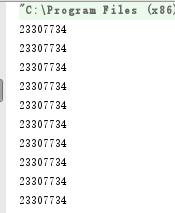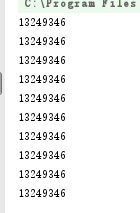都是通过例子来介绍
1.饿汉单例(简单的说就是一上来就创建对象)
先创建一个单例的类MySingleton
package demo01; /** * Created by mycom on 2018/3/6. */ public class MySingleton { private static MySingleton instance = new MySingleton(); private MySingleton(){} public static MySingleton getInstance() { return instance; } }
在编写线程类,并且测试
package demo01; /** * Created by mycom on 2018/3/6. */ public class MyThread extends Thread { @Override public void run() { System.out.println(MySingleton.getInstance().hashCode()); } public static void main(String[] args) { MyThread[] mts = new MyThread[10]; for(int i = 0 ; i < mts.length ; i++){ mts[i] = new MyThread(); } for (int j = 0; j < mts.length; j++) { mts[j].start(); } } }
如果运行的结果所有的都是一样的,说明实验成功,

2.懒汉单例(用到的时候才会创建对象)
线程安全的---方法中声明synchronized关键字
package demo01; /** * Created by mycom on 2018/3/6. */ public class MySingleton { private static MySingleton instance = null; private MySingleton(){} public synchronized static MySingleton getInstance() { try { if(instance != null){//懒汉式 }else{ //创建实例之前可能会有一些准备性的耗时工作 Thread.sleep(300); instance = new MySingleton(); } } catch (InterruptedException e) { e.printStackTrace(); } return instance; } }
package demo01; /** * Created by mycom on 2018/3/6. */ public class MyThread extends Thread { @Override public void run() { System.out.println(MySingleton.getInstance().hashCode()); } public static void main(String[] args) { MyThread[] mts = new MyThread[10]; for(int i = 0 ; i < mts.length ; i++){ mts[i] = new MyThread(); } for (int j = 0; j < mts.length; j++) { mts[j].start(); } } }

3.使用静态内置类实现单例模式(对上面MySingleton的代码进行改动)
package demo01; /** * Created by mycom on 2018/3/6. */ public class MySingleton { //内部类 private static class MySingletonHandler{ private static MySingleton instance = new MySingleton(); } private MySingleton(){} public static MySingleton getInstance() { return MySingletonHandler.instance; } }
测试结果

。。。。。。。